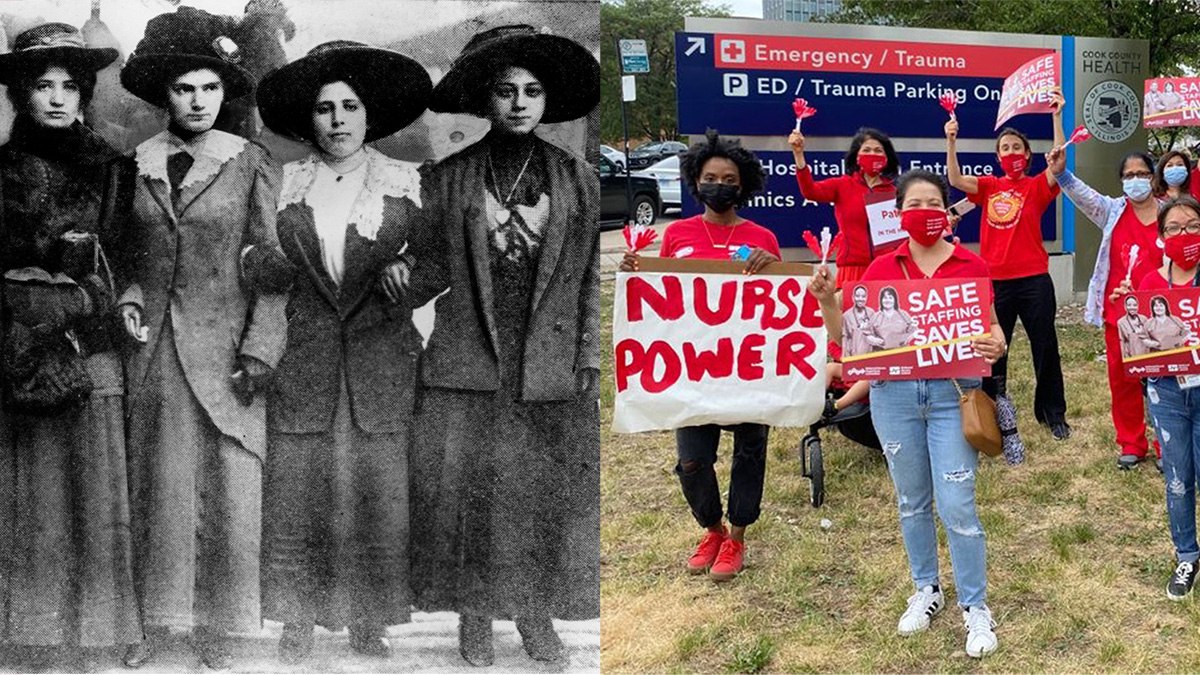Blog
International Working Women’s Day honors a union on strike

In an era of feminist empowerment, of course a day like International Women’s Day is important. But to truly honor this day and its goals, we must revisit the story of International Working Women’s Day, of thousands of fed-up workers boiling over into the streets of New York. We need days like this to remind ourselves to celebrate what we’ve accomplished and still make an honest assessment of what oppresses us.
I’ve seen this firsthand as a registered nurse and as a member, organizer, and now executive director of the largest and fastest growing nurses union in the United States, National Nurses United (NNU). We are nearly 225,000 members strong now in a profession that’s statistically and traditionally gendered for women, who constitute the vast majority of our membership. Our nurses labor in our hospitals and clinics, taking care of you, me, our loved ones, and our communities. NNU nurses have a reputation for being outspoken, for being militant, and for being unafraid to strike when necessary. So we feel a real kinship with the working women who led a history-changing strike that gave rise to this day.
The earliest known “Women’s Day” celebrations were held in New York City in March of 1910 to celebrate garment workers. Over the course of a two-month strike in 1909, these working women changed the course of history and U.S. labor for the better.
While no movement is perfectly embodied by a single leader, Yiddish-speaking immigrant Clara Lemlich was instrumental to the uprising as a leader with the International Ladies’ Garment Workers Union (ILGWU). Lemlich was a key figure in her local labor movement, leading strikes, writing op-eds, and facing physical violence from police and company goons, even once being hospitalized following a beating on a picket line. The two-month strike she helped organize in 1909 was dubbed the “Uprising of the 20,000” as it brought thousands into the streets in a general strike to demand safer conditions for garment workers, a massive workforce largely composed of working-class Jewish immigrants.
The next year, the first National Women’s Day was organized by the Socialist Party of America. Groups across the United States and Europe followed suit, uplifting working women and elevating the day to its international status.
After years as a registered nurse in the labor movement, I see so much of our profession’s story reflected in the garment workers’ story because we, too, have demanded and won better conditions through sustained militant collective action like strikes. At the same time, I’ve seen how misogyny and our profession’s gendered reputation leaves us unprotected. For example, nurses are denied presumptive eligibility for workers’ compensation, something afforded to other frontline, but male-dominated, professions like paramedics, police officers, and firefighters, but not us despite the serious health risks we face.
Like those garment workers, nurses will continue to challenge money-driven health care corporations and take action to demand safer conditions in our workplaces, which means safer staffing, workplace violence prevention plans, and better conditions for our patients. Because right now, we are experiencing high rates of moral distress and moral injury, suffering the crushing weight of knowing the right thing to do but not being able to do it, and that is driving nurses away from the bedside and out of the profession entirely.
Today, lawmakers and executives would do well to heed the lessons of International Working Women’s Day and its history, to be guided by the leadership of working women taking action, not by profits, politics, or preventable tragedy. Hollow platitudes cribbed from the Cliff Notes of feminist theory are no substitute for actually listening to and meeting the demands of working women, especially when we warn them about the life-or-death stakes of problems in our workplaces, whether they’re hospitals, schools, factories, or offices.
Nurses know which side we’re on — the side of our patients and our communities and the side of justice and solidarity. The roots of today’s celebration come from the labor movement, and we all enjoy the fruits of the labor behind it. This International Working Women’s Day, let us celebrate the working women the world over as we remember that the fight that birthed this day isn’t over as long as we keep fighting it every day.